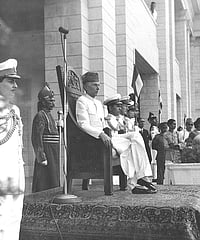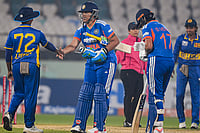A century on, after several popular and scholarly books, it’s hard to say something entirely original about the Jallianwala massacre. But Wagner succeeds in pulling together the threads and presenting all the evidence. He even presents evidence counter to his own ideological craze for deeming the massacre symptomatic of British oppression, rather than exceptional.
To his credit, Wagner eschews any squeamishness in describing anti-European rioting in the Punjab and elsewhere during the days leading up to Jallianwala. Although Mahatma Gandhi had issued a call for peaceful satyagraha, the response was anything but non-violent. A poster on the clock tower next to the Golden Temple called on people to be prepared to ‘die and kill’. There are graphic descriptions of Indian crowds pelting security forces with brickbats and frightening police horses. The British in Amritsar found themselves fending off ‘a determined attempt to rush the Civil Lines’, where most of them lived.
Wagner doesn’t shrink from detailing how three British bank clerks and two railwaymen were unlucky enough to get bludgeoned to death by the mob. Worst of all, Miss Sherwood, a missionary schoolteacher, was knocked off her bike, severely beaten and left for dead.
Gen. Reginald Dyer, later dubbed “the Butcher of Amritsar”, was incensed by all these, most of all by the sight of Miss Sherwood, and by the dormitories of British women and children herded into the old fort. What is missing from Wagner’s account is much clue to Dyer’s psychology, seen as a loner with a chip on his shoulder by his British peers, country-born and bred and popular with his Indian troops. It’s a shock to hear that he was felicitated by the Sikh mahants of the Golden Temple just days after he had ordered the massacre next door.
The mystery at the heart of the massacre remains whether Dyer massively over-reacted on the spur of the moment or whether his was a premeditated plan. Wagner is rightly sceptical about pre-meditation on either the colonial or nationalist side. The latter, he argues, gathered mostly ignorant of Dyer’s ban on public meetings and with no plan of action. Dyer, for his part unfamiliar with the city and with the layout of the Bagh and its tiny exits, might well have seen the meeting as a direct challenge. The horrific result was six to ten minutes incessant firing directly at a crowd of several thousand, resulting in Wagner’s estimate of 500-700 dead and many more wounded.
This book rightly explodes several nationalist myths around the event. There were hardly any women present and few Muslims (only one-sixth of the crowd), despite Amritsar then being a Muslim-majority city. Wagner is convinced that it was memories of the Mutiny of 1857 that shaped the British response in 1919, and he accuses the Raj of paranoia and “racialised violence”. But he pays scant attention to the good intentions of people like Edwin Montagu, secretary of state for India in Britain’s then Liberal government, introducing constitutional reforms designed to take a federal India to responsible and representative government, as in the white dominions of Australia and Canada. Instead, we are told the reforms were designed to perpetuate British power.
Contrary to Wagner’s own assertions of inherent colonial violence, this book supplies plentiful evidence of widespread British revulsion at and condemnation of Dyer’s massacre. The most dramatic examples come from the House of Commons where the massacre was condemned as “un-British” by none other than Dyer’s boss, Winston Churchill, then secretary for war. Poor Montagu was described by Dyer’s Tory supporters as “a Jew rounding on an Englishman and throwing him to the wolves”. Wagner describes how the debate divided not only Parliament but the British press and public, seeing Dyer ejected from the army but receiving a handsome public purse from admirers who saw him as the saviour of the empire.
In India, Gandhi called off his civil disobedience, calling it a “Himalayan miscalculation”. The government set up the Hunter judicial enquiry, with three Indian members who submitted a minority report roundly condemning Dyer’s “inhuman and un-British” methods. One positive note that emerges from this book is that Miss Sherwood returned to the Punjab, aged 70, to help with relief work among Partition refugees. The Bagh itself has become a family picnic park. “The names of the 379 people known to have been killed are nowhere to be found,” Wagner complains, “and, a hundred years after Dyer walked down the narrow passage with his 50 troops, Jallianwala Bagh is no longer a place for mourning the dead, as Gandhi originally envisaged, but a celebration of a nationalist myth.

























